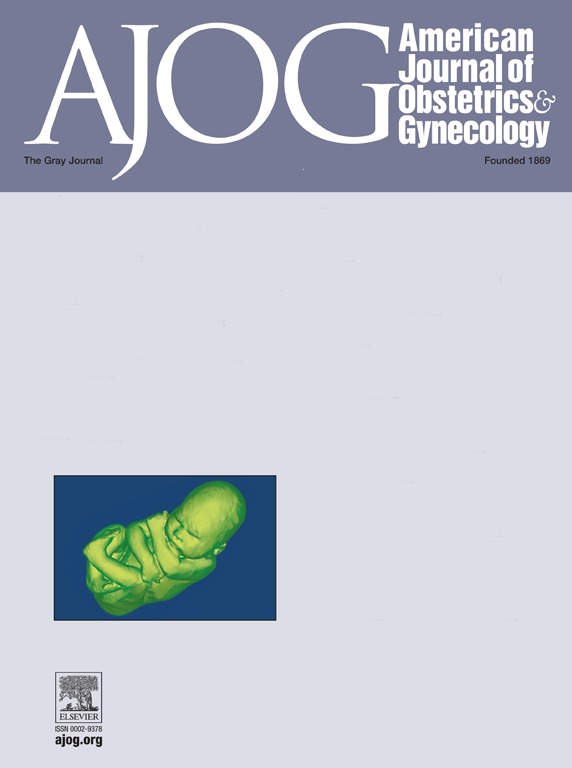妊娠 36 周时的 sFlt-1/PlGF:与低危妊娠中自然临产和产时胎儿受损的关系。
IF 8.7
1区 医学
Q1 OBSTETRICS & GYNECOLOGY
引用次数: 0
摘要
背景:先前的证据显示,胎盘功能障碍会引发自发性早产或足月分娩,以及产中胎儿受损,通常需要紧急分娩,并使胎儿和母亲面临重大风险。预测自发临产和产后胎儿受损可改善产科管理和预后,但目前还很难做到,尤其是在低风险人群中:本研究的目的是在常规检查人群中,通过可溶性酪氨酸激酶-1(sFlt-1)与胎盘生长因子(PlGF)的比值评估36周时的胎盘功能障碍是否与自然临产间隔和需要剖宫产的产中胎儿受损有关:研究设计:对英国伦敦国王学院医院在妊娠 35+0-36+6 周接受常规检查的单胎妊娠妇女的前瞻性数据进行回顾性分析。该研究采用一般线性模型检测了与 sFlt-1/PlGF 比率相关的结果,包括从检测到自然分娩开始的时间间隔,以及随后需要剖宫产的胎儿受损率。进行引产和分娩前剖宫产的患者不在研究范围内。采用竞争风险回归和 Cox 回归模型估算相关结果的累积发生率和风险 结果:在筛选出的 45,375 例患者中,23,831 例(52.5%)自然临产并纳入分析。sFlt-1/PlGF比值˃50与≤50的病例分娩时间提前了约一周(39.2周与40.0周;p˂0.001)。一般线性模型显示,sFlt-1/PlGF比值越大,自然临产越早(随着妊娠期的延长,p50从35%降至0%):这项研究表明,36周时sFlt1/PLGF比值升高与自然临产的胎龄提前和产中胎儿受损率升高有关。该研究有两大意义:sFlt1-/PLGF 比率˃50 表明即将临产,平均风险增加约 40%,因此临床上需要立即对足月妊娠进行监测。此外,sFlt1-/PLGF 比率升高会增加产后胎儿受损的风险,但结果的变异性表明需要在多标志物模型中进行重新评估。本文章由计算机程序翻译,如有差异,请以英文原文为准。
Soluble fms-like tyrosine kinase-1/placental growth factor ratio at 36 weeks’ gestation: association with spontaneous onset of labor and intrapartum fetal compromise in low-risk pregnancies
Background
Previous evidence showed that placental dysfunction triggers spontaneous preterm or term births and intrapartum fetal compromise and often requires urgent delivery, thereby exposing both the fetus and the mother to significant risks. Predicting spontaneous labor onset and intrapartum fetal compromise could improve obstetrical management and outcomes, but this is currently difficult, particularly in low-risk populations.
Objective
The objective of this study was to examine whether placental dysfunction, as assessed at 36 weeks’ gestation by the soluble fms-like tyrosine kinase-1 to placental growth factor ratio, is associated with the interval to spontaneous onset of labor and intrapartum fetal compromise that requires cesarean delivery in a routinely examined population.
Study Design
This was a retrospective analysis of prospectively collected data of women with singleton pregnancies who underwent routine assessment at 35+0 to 36+6 weeks’ gestation at the King’s College Hospital (London, England). Using a general linear model, the study examined the outcomes related to the soluble fms-like tyrosine kinase-1/placental growth factor ratio, including the time interval from testing to spontaneous onset of labor and the subsequent rate of fetal compromise that required a cesarean delivery. Patients who underwent induction of labor or prelabor cesarean deliveries were excluded from the study. Competing risks regression and Cox regression models were used to estimate the cumulative incidence and the risk of the outcomes of interest.
Results
In the screened population of 45,375 patients, 23,831 (52.5%) had spontaneous onset of labor and were included in the analysis. Cases with an soluble fms-like tyrosine kinase-1/placental growth factor ratio >50 delivered about 1 week earlier than those with a ratio of ≤50 (39.2 vs 40.0 weeks’ gestation; P<.001). The general linear model showed that a larger soluble fms-like tyrosine kinase-1/placental growth factor ratio was associated with earlier spontaneous onset of labor (P<.001), particularly among multiparous women. The soluble fms-like tyrosine kinase-1/placental growth factor ratio was significantly associated, as expected, with cases of preeclampsia and advanced maternal age. The cumulative incidence of spontaneous onset of labor was significantly higher in cases with an soluble fms-like tyrosine kinase-1/placental growth factor ratio >50 than in those with a ratio 50 (P<.001). Cox regression showed that the risk for spontaneous onset of labor increased with an soluble fms-like tyrosine kinase-1/placental growth factor ratio >50 (hazard ratio, 1.424; 95% confidence interval, 1.253–1.618; P<.001) and, as expected, the risk was mitigated over time from when the soluble fms-like tyrosine kinase-1/placental growth factor ratio was measured to spontaneous labor onset (P<.001). Cases with intrapartum fetal compromise had a higher mean soluble fms-like tyrosine kinase-1/placental growth factor ratio than those without intrapartum fetal compromise (21.79 vs 17.67; P<.001). Qualitative addition of fetal compromise to the general linear model showed a higher soluble fms-like tyrosine kinase-1/placental growth factor ratio in cases with fetal compromise than in those without fetal compromise (P=.014). Competing risks regression showed a positive dose-response effect for fetal compromise with increasing soluble fms-like tyrosine kinase-1/placental growth factor ratios (P<.001). Above and below the optimal cutoff of 50, the quoted cumulative incidences were 6.7% and 4.7%, respectively (P<.001). The effect of the soluble fms-like tyrosine kinase-1/placental growth factor ratio remained significant even after adjusting for preeclampsia, which is a well-known major risk factor for fetal compromise. Finally, the proportion of cases with intrapartum fetal compromise who had an soluble fms-like tyrosine kinase-1/placental growth factor ratio >50 decreased from 35% to 0% with advancing gestation.
Conclusion
This study showed that an increased soluble fms-like tyrosine kinase-1/placental growth factor ratio at 36 weeks’ gestation is associated with an earlier gestational age at spontaneous onset of labor and higher rates of intrapartum fetal compromise. There are 2 major implications, namely an soluble fms-like tyrosine kinase-1/placental growth factor ratio >50 indicates imminent labor onset with about a 40% mean risk increase and immediate clinical translation for term pregnancy monitoring. In addition, an increased soluble fms-like tyrosine kinase-1/placental growth factor ratio increases the risk for intrapartum fetal compromise, although outcome variability indicates reassessment within multimarker models.
求助全文
通过发布文献求助,成功后即可免费获取论文全文。
去求助
来源期刊
CiteScore
15.90
自引率
7.10%
发文量
2237
审稿时长
47 days
期刊介绍:
The American Journal of Obstetrics and Gynecology, known as "The Gray Journal," covers the entire spectrum of Obstetrics and Gynecology. It aims to publish original research (clinical and translational), reviews, opinions, video clips, podcasts, and interviews that contribute to understanding health and disease and have the potential to impact the practice of women's healthcare.
Focus Areas:
Diagnosis, Treatment, Prediction, and Prevention: The journal focuses on research related to the diagnosis, treatment, prediction, and prevention of obstetrical and gynecological disorders.
Biology of Reproduction: AJOG publishes work on the biology of reproduction, including studies on reproductive physiology and mechanisms of obstetrical and gynecological diseases.
Content Types:
Original Research: Clinical and translational research articles.
Reviews: Comprehensive reviews providing insights into various aspects of obstetrics and gynecology.
Opinions: Perspectives and opinions on important topics in the field.
Multimedia Content: Video clips, podcasts, and interviews.
Peer Review Process:
All submissions undergo a rigorous peer review process to ensure quality and relevance to the field of obstetrics and gynecology.

 求助内容:
求助内容: 应助结果提醒方式:
应助结果提醒方式:


